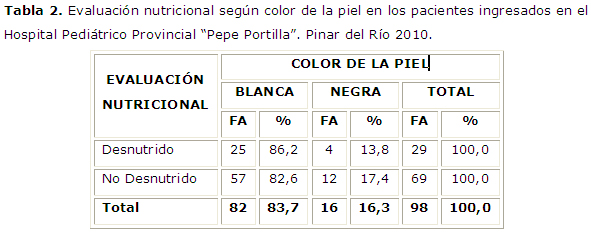Nutritional status of children admitted at “Pepe Portilla” University Children Hospital. Pinar del Rio
Keywords:
Malnutrition, Child, Nutritional status.Abstract
Introduction: the application of the survey concerning pediatric malnutrition at “Pepe Portilla” University Children Hospital becomes into a natural complement of ELANCUBA study, now for Cuban children hospitals.Objectives: to estimate the frequency of energetic nutritional malnutrition among children and adolescents admitted in this hospital, assessing at the same time the current procedures of food provision, nutrients and the use of techniques of common nutritional support.
Material and Method: to carry it out, all children admitted in the hospital were included in the study, children younger than 19 years old with a stay of more than 72 hours in the hospital. Demographic and clinical variables were collected to identify and trace in each child: sex, skin color, health problems and hospital stay (days). Children were measured and weighed, and the surveys of pediatric nutritional risks together with the assessment of hospital malnutrition were both applied.
Results: malnutrition was present in 29% of the children admitted with a higher frequency of onset in children under and equal 2 years old. Despite the frequency of malnutrition found this was not recognized as an independent diagnosis; besides the assessment of anthropometric and biochemical nutritional status in the majority of them was conducted. Observing a low frequency of administration of artificial-nutritional therapy (enteral/parenteral), malnutrition was mostly present in children who suffered from respiratory and digestive conditions.
Conclusion: malnutrition constitutes a health problem among children admitted at “Pepe Portilla” Provincial Pediatric Hospital.
Downloads
References
1. Gibbons T, Fuchs GJ. Malnutrition: a hidden problem in hospitalized children. Clin Pediatr (Phila). [in internet] 2009. [cited july 2011] May;48(4):356-61. Epub 2008 Oct 2. Available from: http://preview.ncbi.nlm.nih.gov/pubmed/18832529
2. Joosten KF, Hulst JM. Malnutrition in pediatric hospital patients: current issues. Nutrition. [in internet] 2011[cited july 2011] Feb;27(2):133-7. Epub 2010 Aug 13. Available from: http://www.nutritionjrnl.com/article/S0899-9007(10)00182-6/fulltext
3. Hernández González J, Rodríguez Ramos W, Breijo Puentes A, Sánchez Portela CA. Prevalencia de la desnutrición hospitalaria en los hospitales Abel Santamaria y León Cuervo Rubio. Revista Cubana Aliment Nutr [in internet]. 2007[cited December 2011]17(1):34-44. Available from: http://www.revicubalimentanut.sld.cu/Vol_17_1/Art3_34_44.pdf
4. Barreto Penié J. State of malnutrition in Cuban hospitals. Nutrition [in internet]. 2005 [cited December 2011]; 21: 487_497. Available from: http://www.nutricionclinica.sld.cu/RecursosGenerales/CubaELAN.pdf
5. Gomila AA, De Grandis ES, Visconti GB, Montero SB, Bertero MI, et al. Nutritional status in children hospitalized in minimum care wards. Hospital de Niños de la Santísima Trinidad. Córdoba. Arch Argent Pediatr. [in internet] 2009. [cited july 2011] 2009 Feb;107(1):37-42. Available from: http://preview.ncbi.nlm.nih.gov/pubmed/19350142
6. Joosten KF, Hulst JM. Prevalence of malnutrition in pediatric hospital patients. Curr Opin Pediatr. [in internet] 2008[cited july 2011] Oct;20(5):590-6. Available from: http://preview.ncbi.nlm.nih.gov/pubmed/18781124
7. Díaz-Argüelles V. La mala nutrición en Pediatría. [in internet]. 2007. [cited December 2011]. Available from: http://www.nutricionclinica.sld.cu/Editoriales/Editorial170603.htm
8. Weisstaub G, Soria R, Araya M. Desnutrición grave en un hospital pediátrico. Rev. bol. ped. [in internet]. 2006[cited December 2011]; 45(2): 90-94. Available from: http://www.scielo.org.bo/scielo.php?script=sci_arttext&pid=S1024-06752006000200003&lng=es
9. Alfonso Novo L, Santana Porbén S. Estado nutricional de los niños ingresados en un hospital pediátrico de la Habana. I. Edades entre 0 y 2 años. Rev Cubana Aliment Nutr [in internet]. 2008 [cited December 2011];18(1):14-31. Available from: http://www.revicubalimentanut.sld.cu/Vol_18_1/Art_18_1_14_31.pdf
10. Alfonso Novo L, Santana Porbén S. Estado nutricional de los niños ingresados en un Hospital pediátrico de la Habana. II. Edades entre 2 y 19 años. Rev Cub Aliment Nutr [in internet]. 2008[cited December 2011]; 18(2):148-165. Available from: http://www.revicubalimentanut.sld.cu/Vol_18_2/Art_18_2_1_148_165.pdf
11. Santana Porbén S, Barreto Penié J, González Pérez TL. Manual de intervención alimentaria, nutrimental y metabólica para Hospitales pediátricos. La Habana: Editorial Palcograf; 2000. p. 1-100.
12. Jordán J. Desarrollo humano. La Habana: Editorial Científico Técnica; 1979. p. 1-100.
13. Sermet-Gaudelus I, Poisson-Solamon A-S, Colomb V, Brusset M-C, Mosser F, Berrier F y cols. Simple pediatric nutritional risk score to identify children at risk of malnutrition. Am J Clin Nutr [in internet]. 2000[cited December 2011];72:64-70. Available from: http://www.ajcn.org/content/72/1/64.full
14. Ulibarri Pérez JL. Nuevo procedimiento para la detección precoz y control de la desnutrición hospitalaria. Nutr Hosp [in internet]. 2002[cited December 2011]; 17:179-88. Available from: http://www.nutricionhospitalaria.com/pdf/3323.pdf
15. Novo LA, Santana S. Estado de la calidad de la prestación de cuidados nutricionales a los niños atendidos en el hospital Pediátrico "William Soler", La Habana, Cuba. Rev Cub Aliment Nutr [in internet]. 2009;19(1):38-55. Disponible en : http://www.revicubalimentanut.sld.cu/Vol_19_1/Articulo_3_19_1_38_55.pdf [Citado el 20 de diciembre del 2011. ]

Published
How to Cite
Issue
Section
License
Authors who have publications with this journal agree to the following terms: Authors will retain their copyrights and grant the journal the right of first publication of their work, which will be publication of their work, which will be simultaneously subject to the Creative Commons Attribution License (CC-BY-NC 4.0) that allows third parties to share the work as long as its author and first publication in this journal are indicated.
Authors may adopt other non-exclusive license agreements for distribution of the published version of the work (e.g.: deposit it in an institutional telematic archive or publish it in a volume). Likewise, and according to the recommendations of the Medical Sciences Editorial (ECIMED), authors must declare in each article their contribution according to the CRediT taxonomy (contributor roles). This taxonomy includes 14 roles, which can be used to represent the tasks typically performed by contributors in scientific academic production. It should be consulted in monograph) whenever initial publication in this journal is indicated. Authors are allowed and encouraged to disseminate their work through the Internet (e.g., in institutional telematic archives or on their web page) before and during the submission process, which may produce interesting exchanges and increase citations of the published work. (See The effect of open access). https://casrai.org/credit/


